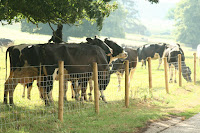10 years ago Edd and Harshani had applied to take part in the Big Allotment Challenge for the first series which was filmed in 2013 and broadcast on TV in 2014 on BBC2. The series was the brainchild of well known TV producer and journalist/author Daisy Goodwin.
We were 1 of 9 couples all brought together with a passion for gardening to create our own allotment plots from scratch in the stunning setting and grounds of Mapledurham Manor House, on the outskirts of Reading.
Our secret location was incredible ~ originally it was called 'The Patch' before being re-named the Big Allotment Challenge for TV showing.
Our first sight was filmed as we all came together and entered the Patch for the first time to discover our allocated plots, empty greenhouses and to begin to create our pre-planned allotment designs.
Our plot was very stony, weedy and was riddled with an old bed of artichokes ~ if you are a gardener you will know what that means . . . we were forever needing to dig these up as the roots kept producing no matter how deep we dug to get them out. So that was Edd's main mission that first weekend to dig over the plot and dig in extra manure which was an entire weekend mission on it's own ~ whilst Harshani started organising the greenhouse and began madly sowing seeds to get things going.
Our brief was that everything had to be grown from seed and only very limited plants were allowed to be from plugs or tubers. We had pre-selected what varieties of veggies and flowers we were going to plant and that was what we then had to stick to. The only established plants we were allowed were potted Roses for one of the later challenges.
We had a plan to create a potager style of planting and we went with a YingYang design for our plot to be created around. We had a guide of what we needed to be planting, but no idea of what the up-coming challenges were going to be.
It was late April, with a completely blank canvas and whilst others started planting things directly in the ground on their plots, Edd was passionate about getting the ground right before planting a thing.
Our style for the series was planting Biodynamically. We had been following Biodynamic gardening at home for the last few years and that is what we brought to our patch.
Biodynamic gardening means planting by the phases of the moon. From sowing seeds, pricking out seedlings, planting out . . . everything was highly co-ordinated and managed by Harshani in harmony with this cycle. Biodynamic is mapped out in 4 categories of Root Days, Leaf Days, Flowers Days and Fruit Days. Harshani had a Biodynamic Calender which is detailed of what days and times of day that each of these can be sown/planted/potted on. We brought into our patch insect friendly, bee friendly plants, companion planting, mad eour own nettle feeds and use organic matter.
Time on the plot each week was limited and each couple were only allowed to be on their plots for 2 full days each week (or however you allocated that time between half days) ~ so time had to managed well for watering, planting, potting on according to this calender too. Our plot needed to be fully estabilished and ready for the competition to begin by June/July.
Gradually over the first few weeks of intensive gardening out patch began to arise. . . .
The story will continue . . .









